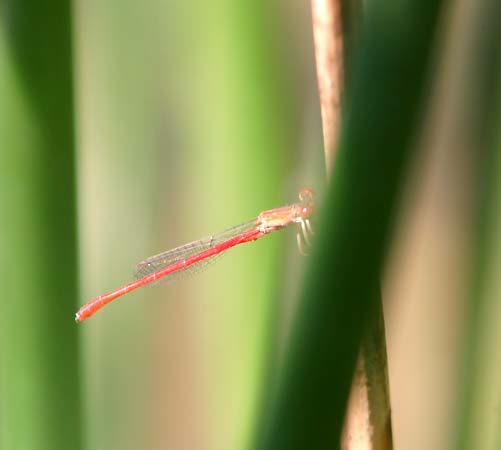DESERT
FIRETAIL
Telebasis
salva
|
|
Desert Firetail is a tiny, exquisite gem. It
is so small (1 inch) and so slim and so retiring that it is easily
overlooked, despite the bright scarlet color of the male (above &
below).
|

|
|
This is actually a very widespread
New World species, with a range extending south of Venezuela. They like
dense marshy habitat and "when flying low over mats of bright green
vegetation, the red males are a striking sight" (Manolis 2003).
|
|

|
Here in MTY, Desert Firetail seems to prefer
tiny seeps covered with duckweed (as in the photos above and below) but
it sometimes is found among reed-lined ponds (left).
Photos (above) 30 July 2006
Lopez Canyon, just west of Pinnacles NM
Photo (left) 24 July 2006 Arroyo Seco Lakes
|
|
|
Female Desert Firetail (right) looks like a
washed-out version of the male, with color patterns ranging from
rusty-red to pale orange.
Photo (right) 21 Oct 2006
Lake San Antonio
Photo (below) 30 July 2006 Lopez Canyon
|
|
|
| DNA evidence suggests that Telebasis
firetails are more closely related to Argia dancers than to
other small damsels (Saux et al. 2003). Like dancers, ovipositing is in
tandem (below). Note the two parallel black bars atop the thorax,
separated by a thin central stripe, on both sexes. |

|
| Desert Firetail was first discovered in MTY on 1
July 2005 by Steve Rovell along the Arroyo Seco River. In 2006, D.
Roberson & Rita Carratello found it at 3 additional sites: (1)
Arroyo Seco Lakes; (2) a spring-fed seep in Lopez Canyon, just west of
Pinnacles Nat'l Monument; and (3) the western shore of Lake San
Antonio. How widely it occurs has yet to be determined. |
|
 The map shows the four sites at which Desert
Forktail has been found. It is likely more common and widespread
elsewhere in the county, but we can hazard a guess that it is limited
to the hot, arid interior. The map shows the four sites at which Desert
Forktail has been found. It is likely more common and widespread
elsewhere in the county, but we can hazard a guess that it is limited
to the hot, arid interior.
In MTY flight dates stretch only from 6 May
to 21 October. Elsewhere in California, flight dates span Apr–Oct
(Manolis
2003).
|
|
Literature cited:
- Manolis, T. 2003. Dragonflies and Damselflies of
California. Univ. of Calif. Press, Berkeley.
- Saux, C., C. Simon, and G.S. Spicer. 2003. Phylogeny
of the
dragonfly
and
damselfly Order Odonata as inferred by mitochondria 12S ribosomal RNA
sequences.
Ann. Entomol. Soc. Am. 96: 693-699.
Web resources:
Major identification web sites with much information on California
odes include:
For sites with excellent photos to compare for identification or to
simply
enjoy, see:
Many of these sites have links to other useful pages. Kathy Biggs's
site
is particularly useful in her selection of links. |
